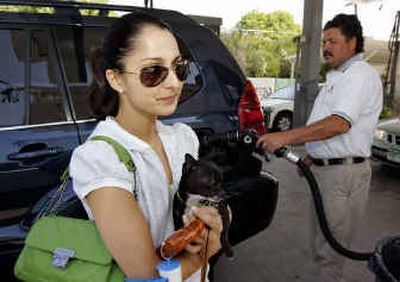Profits are at a premium

WASHINGTON — It sounds hard to believe, but gasoline retailers’ profit margins are at a 20-year low.
Even more surprising, their troubles are being exacerbated by high pump prices. That has prompted motorists to avoid premium-grade gasoline and pay more often with credit cards — both of which reduce earnings that already were just a few pennies per gallon.
Coupled with rising competition from Wal-Mart, Costco and other discounters, these purchasing trends have reinforced the importance of an industrywide shift toward bigger facilities that sell more snacks, sodas and services that deliver higher profits.
In a sign of just how critical non-fuel sales have become, the independently owned Majestic Car Wash and Chevron gas station in Los Angeles is now offering a 10-cent-per-gallon discount to customers who get their car washed when they tank up.
Angela Nolan, 23, gladly took advantage of the offer the other day, pumping $39.20 worth of premium unleaded into her Lexus SUV. Nolan paid with a credit card, which will sap some of the profit from the transaction. But by choosing premium fuel, she allowed Majestic to make a few cents per gallon more profit than regular unleaded.
Nationwide, premium grade gasoline accounted for 10 percent of retail sales in 2004, about half the market share it held in 1994, according to government statistics.
Partly because of that, the average gross profit margin on gasoline sales fell to 10.46 cents per gallon last year, according to the National Association of Convenience Stores, an Alexandria, Va.-based trade group that represents the interests of gasoline retailers. As a percentage of the average pump price, that’s the lowest it has been since 1984.
And the squeeze could get tighter: Since January, the average price of regular unleaded gasoline in the U.S. has climbed 28 percent to $2.28 a gallon, up nearly 50 cents from a year ago. Over the same period, the price of premium unleaded rose 24 percent to $2.46 a gallon. The run-up followed a surge in crude oil futures, which settled Friday at $50.49 a barrel on the New York Mercantile Exchange.
Jay Witkowski, a 26-year-old Chicagoan, said he’s going to keep paying extra for premium gasoline for his Audi A6 no matter what the cost, but joked, “I might have to sell the car to pay for the gas.”
Tired of tanking up her new Mercedes-Benz with premium gasoline that costs nearly $3 a gallon, 38-year-old Kim Williams of Los Angeles said she is considering switching to lower octane fuel. “I heard you don’t really need high octane for this kind of car,” she said.
Score one for the grapevine: Several automakers confirmed that their recommendations regarding premium fuel are just that.
“The car will run on regular fuel without damaging the engine,” said Martin Peters, manager of public relations for Porsche Cars North America Inc., the Atlanta-based subsidiary of Porsche AG, which like other automakers recommends premium fuel for all of its cars for “optimum performance.”
But is the difference significant enough for the average driver to notice?
“On a racetrack you’d be able to tell,” said Kyle Johnson, a spokesman in Pontiac, Mich. for General Motors Corp., which recommends the highest octane fuel for Corvettes. “But in most driving situations, you’re not going to notice it, like just driving around town or even cruising on the highway.”
Of all the places to buy gasoline, less than 10 percent are owned by oil companies and refiners, according to the Department of Energy. That is down from about 15 percent in 1998, reflecting the industry’s efforts to shed these less profitable assets and to focus instead on production and refining.
In contrast, hypermarkets — supermarkets, mass merchandisers and discount stores that sell gasoline in their parking lots as a way to lure shoppers — now account for 8 percent of sales and could grow to 15 percent by the end of the decade, according to Energy Analysts International of Westminster, Colo.
Overall, the total number of gasoline retailers fell to about 167,000 In 2004 from more than 200,000 a decade earlier, according to National Petroleum News, an industry publication.
For those still in business, revenue from car washes, fast food sales and ATM transactions in recent years has helped offset declining margins at the pump.